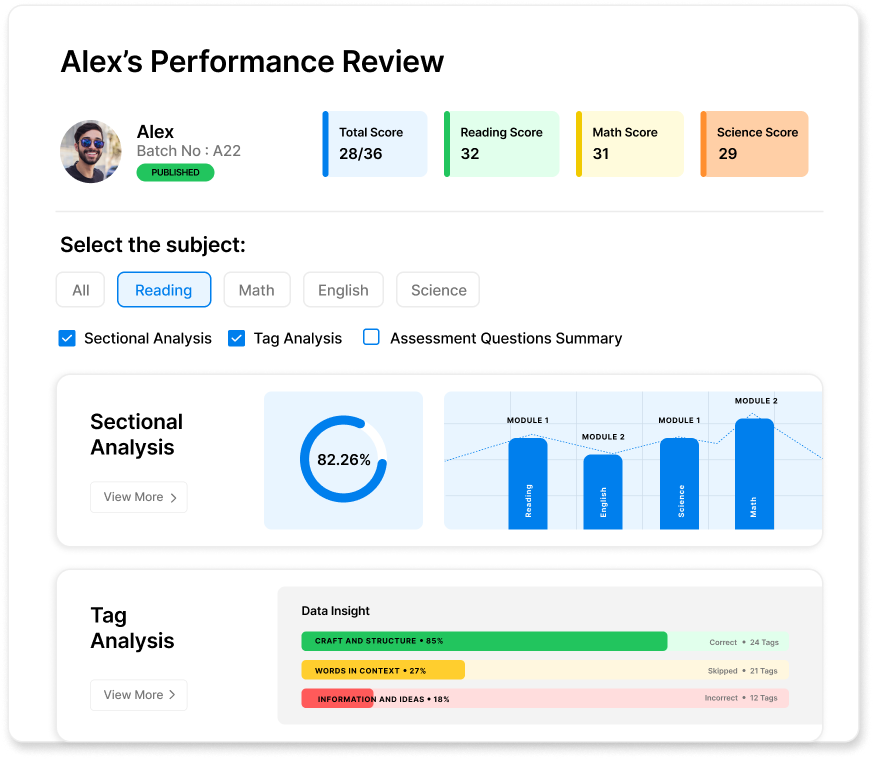




Key Takeaways
- ACT plateaus happen when effort stops being strategic, not from lack of ability.
- Breaking plateaus requires targeted review, error logs, and smarter pacing—not more tests.
- Data-driven analysis helps tutors pinpoint weaknesses and turn small gains into score breakthroughs.
ACT prep often starts with a rush of progress. Scores climb fast as you get comfortable with the test and build basic skills. But after a point, many students hit a frustrating wall where their scores just stop improving. No matter how many practice tests they take or how much time they put in, the results barely budge. It can feel like a personal failure, but it is not.
At this stage, success depends on shifting from doing more practice to practicing smarter. Students need to dig deeper into why mistakes happen instead of just doing more problems. And tutors need to shift from simply teaching content to diagnosing patterns, using data and analysis to spot weak points that hold students back.
Let’s understand this mysterious plateau in detail.

What is an ACT score plateau?
An ACT score plateau happens when your overall or section scores stop improving, even though you are studying regularly, or maybe even harder than before. It’s a common and discouraging stage in prep, where all the extra effort does not seem to pay off.
Most students hit this wall at one of two key score ranges, and each stage calls for a different plan to break through and start improving again.
The mid-range plateau (24–28)
A composite score in this range usually means you’re already doing better than most test-takers (which is roughly around the 85th to 93rd percentile). But moving beyond this point takes more than just learning new material. To push into the 30+ range, you will need to sharpen higher-level math and reading skills while tightening up your timing and test strategy. At this stage, improving is less about memorizing more facts and more about fixing how you apply what you already know under pressure.
The high-score plateau (32–34)
For top scorers, the plateau looks different—and can be even more frustrating. Scores in this range (roughly the 94th to 98th percentile) are tightly packed, meaning even small mistakes can block progress. You might understand everything conceptually, but still find your composite score barely moving. That’s because the scoring scale is so compressed that every single question counts. It can feel like you’re not improving, even when you are. Breaking through this level is not about big content gaps anymore—it is about fine-tuning precision, identifying subtle timing issues, and eliminating tiny, consistent errors that cost points.
Why do ACT score plateaus occur?
The main reason students hit an ACT score plateau is not lack of effort—it is that their effort stops being effective. Let’s understand this better.
The “Repetition Trap” and missing reflection
The main reason students hit an ACT score plateau is not laziness, but inefficiency. Most fall into what’s called the “Repetition Trap” (doing more of the same kind of practice without learning anything new). They take test after test, hoping effort alone will lead to improvement, but without reflection or strategy, the results stay the same.
Over time, this just reinforces their weaknesses instead of fixing them. Real progress starts when you slow down and analyze why you got questions wrong, not just how many.
Burnout as a self-imposed barrier
When your score stops moving, the natural instinct is to study harder. Ironically, that often makes things worse. Long, non-stop study sessions and over-cramming cause mental fatigue, which kills focus and memory retention. Burnout shows up as careless errors, slower recall, and even physical signs like poor sleep or frustration.
Study in focused hours, take regular breaks, and give your brain space to rest. Recovery time is not optional; it is part of effective prep.
Roadblocks preventing improvement
When the prep effort is plateauing, the issue often resides in specific, measurable failures of execution or focus during the test-taking and review process.
1. The missing review cycle
The biggest mistake students make is skipping a structured review. Simply checking which answers were right or wrong is not enough. You need to dig deeper: Was it a silly mistake? A time issue? Or did you not understand the concept at all?
Categorizing each error helps you target exactly what to fix.
2. Pacing pitfalls and “learned panic”
Students often rush through the first half of a section to “save time” for harder questions—but that strategy can backfire. Easy points are lost to small mistakes, while hard questions still eat up time. Remember: all questions are worth the same.
For Reading and Science, aim for roughly 8 minutes and 45 seconds per passage. If you spend over 10 minutes on one, you’ve likely lost time you can’t make up.
3. Unbalanced or incorrect content focus
In the 28–32 score range, small knowledge gaps start to matter. Maybe your grammar is fine, but your rhetorical reasoning is not sharp enough, or your math is strong, but you keep missing graph-based Science questions.
At this stage, you need precision. Focus on the exact question types you miss repeatedly instead of doing random drills.
The following table explains the most frequent strategic roadblocks and provides targeted solutions:
ACT score plateau diagnostic: Problems, causes, and solutions
If your study habits seem solid but your scores refuse to budge, the problem might not be your prep—it might be your mindset.
Mental and behavioral causes of ACT score plateaus
If, despite trying all strategies, you feel stuck, the underlying reason might be more psychological than practical. Here are some roadblocks that might be in your way:
The fixed mindset barrier
A fixed mindset makes you believe your abilities are set in stone—that you are “just bad at science” or “not a math person.”
Breaking through this plateau requires a shift to a growth mindset—the understanding that skills can be built through targeted effort and feedback. The ACT is not random; it is predictable and learnable. Students who view each missed question as training data, not failure, make steady progress.
Anxiety and the feeling of unpreparedness
Interestingly, the biggest cause of test anxiety is not the test itself, but the feeling of being unprepared.
Research shows that high anxiety correlates with lower scores, not because students suddenly forget content, but because anxiety blocks access to what they already know.
The best solution is not just relaxation, but preparation that builds real confidence. Following a clear study plan, tracking progress, and seeing measurable improvement gives students a sense of control that naturally reduces anxiety. Combine this with consistent sleep, a good breakfast, deep breathing, or positive self-talk to manage nerves on test day.
Feeling prepared is the most powerful stress reliever!
Smart study strategies to break the plateau
Breaking the score plateau requires a shift from passive consumption of practice material to active, analytical engagement.
1. Master the error log
An error log (or summary sheet) is non-negotiable because it is the most effective way to break a plateau. Instead of glancing at your graded test, take time to record and reflect on every question you missed or guessed. A good error log should include:
By regularly reviewing this log, you start seeing patterns in your mistakes and can adapt your study plans to target the right weaknesses.
2. Create "variant questions"
If a question asked you to find the largest value on a graph, rewrite it to ask for the smallest. If it were about one variable, change it to two. These “variant questions” force you to truly understand the concept instead of memorizing one specific solution. The deeper your engagement with the material, the more flexible and confident you become on test day.
3. Goal-based, purposeful study sessions
Plateaus often happen when study sessions lose direction. Instead of vague goals like “improve math,” focus on micro-goals that directly address your weak areas. For instance: “Rework the 10 questions tagged ‘Transition Words’ from the last test” or “Drill 5 geometry problems under 5 minutes.” These focused sessions, even if just 20–30 minutes long, train your brain to think with precision and intention.
Advanced prep techniques for tutors and educators
For tutors, a student’s score plateau means shifting from broad, content-heavy lessons to diagnostic-driven, precision teaching. The best educators move from intuition to data, and from general instruction to hyper-personalized coaching.
1. Moving beyond intuition with diagnostics
Many tutors keep reteaching the same topics after a plateau, assuming repetition will fix the issue. It rarely does. The real breakthrough happens when you act like an educational diagnostician. Instead of guessing what the student needs, use diagnostic assessments and detailed score reports to pinpoint the exact skills holding them back.
For example, instead of saying, “You’re weak in Science,” dig into the data until you can say, “You’re missing 70% of model evaluation questions because you misread contradictory graphs.” That level of clarity turns vague frustration into a concrete action plan.
2. Personalized pacing interventions
Pacing often decides whether a student’s knowledge actually turns into a higher score. To fix timing issues, train students through structured pacing drills.
Start with a baseline check using diagnostics to measure how long students spend per passage or question group. Then, run targeted drills focused purely on speed—for example, completing a Reading passage in exactly eight minutes to build control under pressure. Finally, teach batch bubbling, where answers are filled in after every 10 questions or at the end of a passage.
3. The art of variable practice and skill isolation
To stop students from memorizing patterns instead of truly learning, keep practice varied. Mix timed and untimed drills so students can alternate between accuracy and speed. This builds both precision and adaptability.
You can also use skill isolation, designing short practice sets that target only one weakness—like modifier errors or graph interpretation. This approach ensures students actually understand the concept behind each problem, rather than just recognizing question types.
How to Adjust Your Practice Tests & Timing
When scores stop improving, most students assume the solution is to take more full-length practice tests. But this often backfires. Repeating 3.5-hour tests without meaningful review wastes official materials and strengthens bad habits instead of fixing them.
Prioritize review over volume
Follow a simple rule: your review time should be twice your test time. For every three hours spent taking a test, spend at least six hours analyzing errors, identifying patterns, and practicing weak skills. The 2:1 ratio ensures that each test contributes to growth rather than just repetition.
Strategic use of mini-tests and section-based drills
If your plateau is limited to one or two sections, use mini-tests or section-based drills instead of full exams. These shorter, targeted tests allow you to focus energy where it is needed most. They’re also ideal for pacing practice; for instance, try completing a 40-question Reading section in 40 minutes to simulate digital ACT timing.
Mini-tests save energy, preserve official test materials, and provide sharper feedback on specific weaknesses.
How EdisonOS helps you overcome plateaus
Breaking a score plateau needs more than effort—it needs precision. EdisonOS gives tutors and students the tools to diagnose issues, design focused strategies, and track real progress instead of guessing what’s wrong.
Smart diagnostics and deep insights
EdisonOS goes beyond raw scores. Tutors can run diagnostic tests, analyze time spent per question, and spot subtle issues like pacing or second-guessing. Its detailed dashboards turn every test into data you can act on, revealing exactly what’s holding a student at a 29 instead of a 31.

Personalized practice and measurable progress
Once problem areas are identified, tutors can build custom study paths using EdisonOS’s Curriculum Builder. With Build Your Own Tests (BYOT), they can generate targeted quizzes based on real analytics. Progress dashboards then track every gain, showing whether new strategies are actually working.

EdisonOS makes prep efficient, data-driven, and tailored, helping students turn plateaus into measurable growth.
The bottom line
The ACT score plateau is a signal to change strategy. Most students hit this wall when practice volume stops producing results. The key is not working harder but working smarter, shifting from repetition to reflection and precision.
To move forward, students must make three key changes: embrace a growth mindset that views mistakes as insights, use an error log to identify why each mistake happened, and sharpen pacing to protect easy points while managing time on harder ones. Progress happens when practice becomes intentional, not mechanical.
For tutors, breaking a plateau means using technology to pinpoint what the eye can’t see. Platforms like EdisonOS allow precise diagnosis of timing, comprehension, and content gaps. With data-backed personalization, tutors can replace guesswork with targeted action—helping every student move from frustration to measurable growth.
Frequently asked questions
Subscribe to
our Newsletter
Subscribe to our Newsletter
To know about the latest Insights & updates of EdisonOS!


.png)








.png)
.webp)
